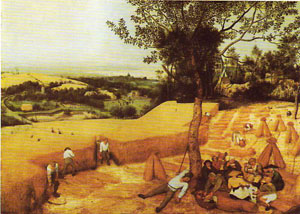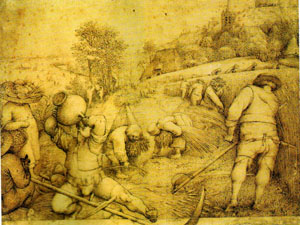|
|
Pieter Breughel the Elder is the most famous Netherlands painter of the 16th century. He was born in 1526, just a few years after 1500, usually seen as the end of the Middle Ages in central and northern Europe. The son of a peasant, we hear of him first with his entrance into the Antwerp painters' guild in 1551. After his marriage in 1563, the couple moved to Brussels, where he fathered two sons before his death in 1569.
While the range of Breughel's pictures give an almost encyclopedic glimpse into the daily life of his time, he also painted series of pictures dealing with human frailties, with scenes from the Bible and with death and Hell. His pictures portraying the seasonal work of the peasants are of most interest to us here, particularly the Wheat Harvest, which hangs in the Metropolitan Museum of Art in New York.
Breughel-Harvest (click photo to enlarge)

As we look at this picture, we can almost feel the late afternoon heat of a July day as we view the scene from above. The theme of the picture, the wheat harvest, is linked with the subject of rest from labor, as we look at several groups of peasants, some in the foreground, others stationed at different points in the painting.
You may also be interested in comparing his drawing "Summer" from 1568: (click photo to enlarge)

Exercise for Students
What do we see in this picture? [suggested interpretations in brackets]
- Look at the biggest group of peasants, the one under the tree
- How many of them are there?
- What are they doing?
- sleeping-why?
- eating- What? [bread, porridge, fruit?, perhaps a pear, they are under a pear tree] Why bread? [Bread was main staple of diet]. Why is bread important in this picture? [Wheat harvest will bring more grain.]
- How can we tell the peasants are tired? [They are concentrating on eating, drinking and resting-only 3 of them have their full faces towards the onlooker and none of them are focused on him. One of the women sits with her back to the onlooker.]
- How are the peasants harvesting the grain? [with a scythe] Why is the grain as tall as the peasants? [It was a pre-hybrid wheat, which put much of its energy into the stalk.]
- What is the man in the field behind the resting workers doing? [He is tying the grain in shocks.] What is the woman doing in the field behind the resting workers? [taking bundles of grain to the man] Why is this women's work? [Scythes are heavy and take a lot of strength to handle.] Why is the grain put in shocks? [for the purpose of taking it to the barn and threshing it] Why are the shocks standing instead of lying in the field? [If it rains, the water will run off and will not rot or cause mold in the grain.] Can we see this type of wheat harvest today? [yes, among Old Order Amish]
- What do we see behind the trees and bushes? [a village with a church, where the peasants live]
- In the middle of the picture, to the left, we see two more men with scythes, plus a man coming out of a pathway through the field. What is he carrying? [a jug] Three women walk in the other direction on the path. What are they carrying? [shocks of wheat] Where are they taking the shocks? [to a very full wagon hitched to a horse]
- Further back in the picture, there is another village and individual peasant settlements, with houses and barns. Can you find the pond with people swimming to cool off? Next to it is a grassy field, where a game is in progress. A bird, either a rooster or a goose, is tied down, and boys are throwing sticks at it. Whoever can catch the bird before it stands up again wins it.
- Breughel's picture has its antecedents in the labors of the months, which were very popular illustrations for household prayer books for wealthy middle and upper class patrons. The motifs of wheat harvest and thirsty workers are common for July and August.
Sources
- Wolfgang Stechow, Pieter Breugel the Elder, New York, 1969.
- Walter S. Gibson, Breugel, London, 1977.
- Henisch, Bridget Ann, Labors of the Month
Vickie Ziegler
Penn State University Center for Medieval Studies

|
|
|




